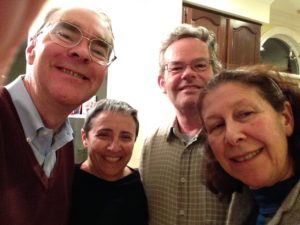 Thursday was a lazy day around the RV, ending with a lovely dinner with David and Lucie. (Gotta get some recipes.) Even Rumple was happy playing with their puppy Buttercup.
Thursday was a lazy day around the RV, ending with a lovely dinner with David and Lucie. (Gotta get some recipes.) Even Rumple was happy playing with their puppy Buttercup.
Friday, Lucie and I left for Washington. We spent the night with Lucie’s sister Yvonne and her husband Paul in Columbia, MD. Columbia is a story in itself – a planned community with planned “interfaith centers” instead of houses of worship devoted to a single religion, and odd street names selected by literature enthusiasts. (How would you like to live on “Broken Land Ave”?) The interfaith centers were established to keep most of the development in taxable property – not to promote interfaith understanding, although I am sure that is a side effect.
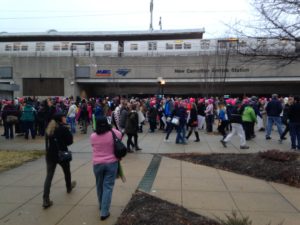 We got up early to take the Metro into Washington. It was at 7:15 a.m. at the last stop on the Orange Line that we realized the scope of the protest – the lines for tickets and for entry were enormous! There was a sea of happy people, with fuschia and pink hats bobbing in great numbers in the crowd. Fortunately, Paul and Lucie had the foresight to purchase our tickets the previous evening, and so our wait for the train was short. Anyone who planned to catch the train closer to Washington, including those poor souls trying to get to work, had a tough time getting onto crowded cars.
We got up early to take the Metro into Washington. It was at 7:15 a.m. at the last stop on the Orange Line that we realized the scope of the protest – the lines for tickets and for entry were enormous! There was a sea of happy people, with fuschia and pink hats bobbing in great numbers in the crowd. Fortunately, Paul and Lucie had the foresight to purchase our tickets the previous evening, and so our wait for the train was short. Anyone who planned to catch the train closer to Washington, including those poor souls trying to get to work, had a tough time getting onto crowded cars.
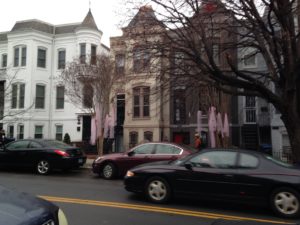 We got off the train outside the main march area, as we were supposed to meet up with members of Yvonne’s union at Farragut Park to march together. The residential neighborhood we walked through was uncrowded, but many lawns and windows had signs welcoming the marchers – note the pink ribbons hanging from the trees in the background. I am guessing that the new administration is not too popular among the people who will have to work for it.
We got off the train outside the main march area, as we were supposed to meet up with members of Yvonne’s union at Farragut Park to march together. The residential neighborhood we walked through was uncrowded, but many lawns and windows had signs welcoming the marchers – note the pink ribbons hanging from the trees in the background. I am guessing that the new administration is not too popular among the people who will have to work for it.
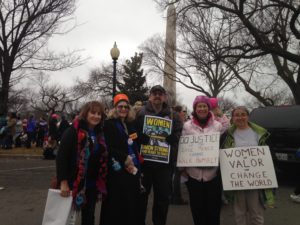 Farragut Park was full of marchers – a Japanese-American group with drummers, several unions, immigrant groups, etc., but only one other person from Yvonne’s teachers union. After a while, the groups coalesced into a march towards the main march. As an immigrant myself, I decided to march with an immigrant group (CAVA) right behind my friends. (My group of friends are in the picture above, with Lucie to the right and Yvone to the left.) Most of the people with me during this part of the march were speaking Spanish, but my main marching buddy was from Nigeria (which I consider my 3rd country, after Canada and the US).
Farragut Park was full of marchers – a Japanese-American group with drummers, several unions, immigrant groups, etc., but only one other person from Yvonne’s teachers union. After a while, the groups coalesced into a march towards the main march. As an immigrant myself, I decided to march with an immigrant group (CAVA) right behind my friends. (My group of friends are in the picture above, with Lucie to the right and Yvone to the left.) Most of the people with me during this part of the march were speaking Spanish, but my main marching buddy was from Nigeria (which I consider my 3rd country, after Canada and the US).
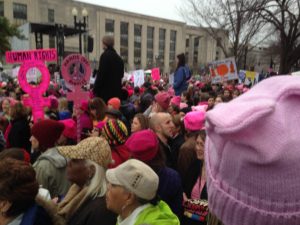
There was a lot of signage, some of it quite clever. Lucie had suggested that we make our own signs the night before, which was a bit like being in elementary school again. After scouring the internet for a good slogan, she settled on “Women of Valor can Change the World”, while I settled on “Do Justice, Love Mercy, Walk Humbly – be the change”. Both of us wanted something positive and not pointing directly at Trump. However, I now feel that mine was a little too biblical.
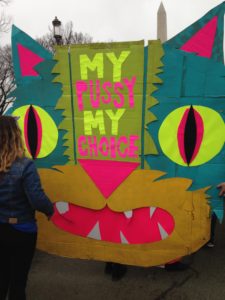
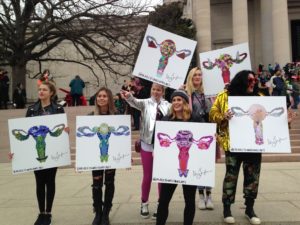
People were marching for all sorts of reasons and there was a lot about “pussy grabbing”, reproductive rights and “Nasty Women”. There were a lot of women my age and older with signs like “50 years later – I cannot believe I still need to protest this stuff” and “Now you’ve pissed off Granny”. There was also a lot of Gay Pride signage and a lovely poster of a woman in a headscarf in a US flag print (and a real marcher who looked just like her). There were also a lot of personal attacks on Trump’s appearance and some of his weirder boasts. A fair number of signs supported immigration, denounced the “Muslim registration” idea, etc. And of course there was a lot about the environment. I did not see much about the free trade deals – I guess the left does not like them either.
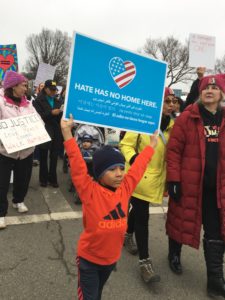 It was heartening to see the number of people who brought kids – in some cases 3 or even 4 generations of women and some men marching together. (I got the permission of this young marcher’s mom to post his picture.)
It was heartening to see the number of people who brought kids – in some cases 3 or even 4 generations of women and some men marching together. (I got the permission of this young marcher’s mom to post his picture.)
There was a lot of chanting, too – “Show us what democracy looks like. This is what democracy looks like.” “Se puede”. Anti-Trump slogans, etc. Not much singing – although the press reported that the crowd had selected an “anthem” the only song I heard was “If I had a hammer”.
As the stream I was walking with merged with other streams and became a river and then a sea, it became apparent that the number of protesters was far beyond what the organizers had expected (200K) and more like 500K. Pausing for a moment to take a picture (against Lucie’s advice) I managed to lose my group in the crowd. I was able to follow some large posters that had been in our group, but apparently Lucie et al got swept into another group. Cell reception was spotty to non-existent due to the crowd.
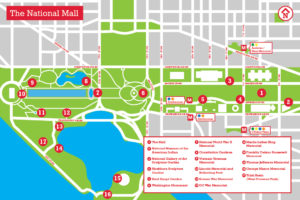 We were pushing towards the speakers’ stage which was between the National Museum of the American Indian (NMAI) and Independence Ave. However, the route was blocked. The police monitoring the march told everyone this but people continued to push forward – some because the stage was in sight, some because they were being pushed from behind and me because I was sure my group was ahead.
We were pushing towards the speakers’ stage which was between the National Museum of the American Indian (NMAI) and Independence Ave. However, the route was blocked. The police monitoring the march told everyone this but people continued to push forward – some because the stage was in sight, some because they were being pushed from behind and me because I was sure my group was ahead.
I have to say I was having a pretty good time. After someone announced that she was from Ottawa, I started asking people where they were from and chatting. People were in a really good mood and everyone was happy to chat. Although there were only a few people between me and the stage, nothing could be heard to the side or back. I listened to some of the speeches later that evening on TV.
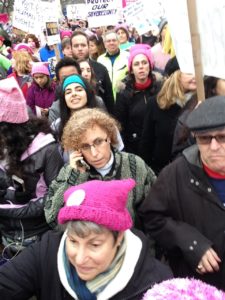 Finally I got a text stating that Lucie et al were on the Mall near the National Gallery, so I started to make my way back towards them. By this time a couple of marchers had started to direct traffic, which helped a lot and it did not take too much to get to the Mall. However, there were still hundreds of thousands of marchers. After a while, the march started to proceed in 3 streams, along Jefferson, Madison and Constitution, so I waited downstream from the National Gallery, figuring I would see my friends when they passed. When this did not happen, I strolled back to the National Gallery, and finally caught up with them when a text got through.
Finally I got a text stating that Lucie et al were on the Mall near the National Gallery, so I started to make my way back towards them. By this time a couple of marchers had started to direct traffic, which helped a lot and it did not take too much to get to the Mall. However, there were still hundreds of thousands of marchers. After a while, the march started to proceed in 3 streams, along Jefferson, Madison and Constitution, so I waited downstream from the National Gallery, figuring I would see my friends when they passed. When this did not happen, I strolled back to the National Gallery, and finally caught up with them when a text got through.
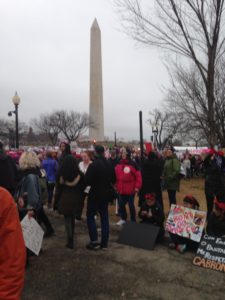 With that, we all marched towards the Washington Monument, from where the march was supposed to walk past the White House. Of course, the 3 streams merged there, and there was a huge amount of confusion, as the police were not prepared to handle a crowd this big, and with minimal cell signal there was no way to redirect the group. Amazingly, in this mess Lucie received a text from her son Isaac, and we were able to meet up with him, too.
With that, we all marched towards the Washington Monument, from where the march was supposed to walk past the White House. Of course, the 3 streams merged there, and there was a huge amount of confusion, as the police were not prepared to handle a crowd this big, and with minimal cell signal there was no way to redirect the group. Amazingly, in this mess Lucie received a text from her son Isaac, and we were able to meet up with him, too.
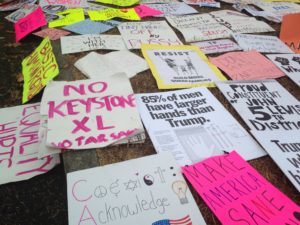
Finally the crowd was redirected to the Oval. People just kept coming and coming. Most of the out-of-town buses were supposed to leave around 4:00, but it was 4:30 and the bulk of marchers were still streaming in! People began to leave their signs as a display against fencing and on the ground as they left. We decided to do the same, especially as some members of our small group were beginning to fatigue.
Despite our intention to leave as soon as possible, we found it impossible. The Metro was so jammed that at our station the Metro staff were asking people to leave the station temporarily. Fortunately we found a place nearby to stop for a snack and left without any problem around 7:30. As the train passed the out-of-town bus parking we saw that the lot was still almost full! The train that had been packed on the way in was practically empty, although the trains in the other direction were still jammed.
We got back to Yvonne and Paul’s place in time to watch the whole thing again on the news and listen to some of the speeches.
What astonishes me in retrospect is that there were no confrontations with Trump supporters, who had been there for the Inauguration only a day earlier. A few bemused families wearing Trump paraphernalia meandered through the crowd but everyone was friendly. It would have been a perfect situation for a few provocateurs to start a disturbance. I am very grateful that it did not happen – all the marches around the country proceeded without incident. I might add that the police presence was light and the officers were friendly. People were thanking them for being there.
I am now left with the question of what to do to further the causes for which I marched. Fortunately, my phone works from anywhere in the US or Canada.
The weekend ended with our drive back to North Carolina, with time out to visit with Isaac and with David’s lovely mother.
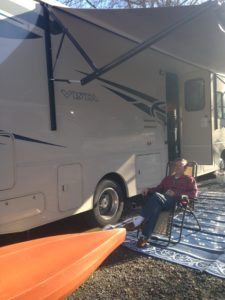 Jan. 25: Our first day near Charlotte was Naomi’s birthday and a beautiful warm sunny (although windy) day. However, Chuck decided to bring the car in for servicing and it turns out there was a door latch recall which took all day to remedy. As a result, we traipsed around in the woods near the campground and used our lawn chairs for the first time on this trip.
Jan. 25: Our first day near Charlotte was Naomi’s birthday and a beautiful warm sunny (although windy) day. However, Chuck decided to bring the car in for servicing and it turns out there was a door latch recall which took all day to remedy. As a result, we traipsed around in the woods near the campground and used our lawn chairs for the first time on this trip.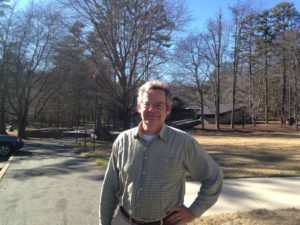 In keeping with our theme of “National Parks” we headed out to the Kings Mountain National Military Museum, which is the site of a 1780 battle in the Revolutionary War. This was really a civil war – the Loyalists were headed by a British officer, Ferguson, but were otherwise all Americans; the Patriots were the mountain men who had been neutral until the Brits threatened to literally burn them out. Ferguson was heading 1/3 of the Loyalist forces, and had asked for reinforcements from Cornwallis and Tarleton who headed the remaining forces.
In keeping with our theme of “National Parks” we headed out to the Kings Mountain National Military Museum, which is the site of a 1780 battle in the Revolutionary War. This was really a civil war – the Loyalists were headed by a British officer, Ferguson, but were otherwise all Americans; the Patriots were the mountain men who had been neutral until the Brits threatened to literally burn them out. Ferguson was heading 1/3 of the Loyalist forces, and had asked for reinforcements from Cornwallis and Tarleton who headed the remaining forces.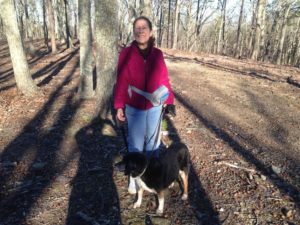 The site has since been lumbered, so there is second growth forest now – still fairly open between the trees, but with a lot of brambles off the trail. However, it was a nice walk around the base and up to the top of the hill. There are also several trails in the area.
The site has since been lumbered, so there is second growth forest now – still fairly open between the trees, but with a lot of brambles off the trail. However, it was a nice walk around the base and up to the top of the hill. There are also several trails in the area.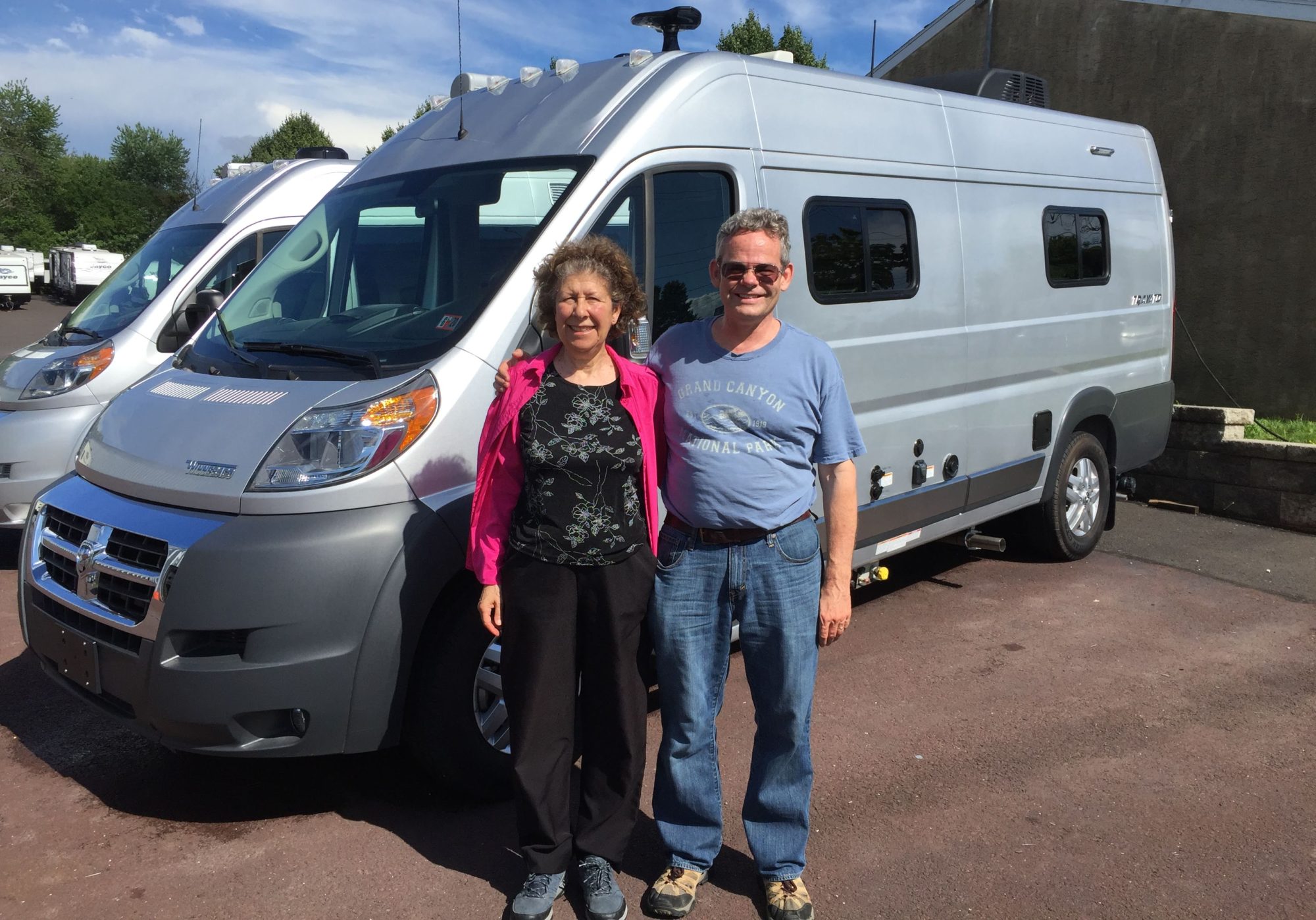
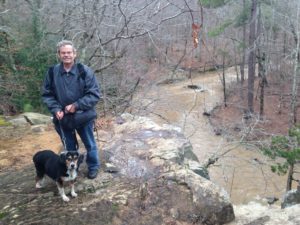 Instead, we went for a long hike in Duke Forest along New Hope Creek, which was very nice (although it would be nicer in the summer with leaves on the trees). We were just a few blocks from David and Lucie’s home, so we met up with them for dinner as well, making a nice end to our time in the Triangle.
Instead, we went for a long hike in Duke Forest along New Hope Creek, which was very nice (although it would be nicer in the summer with leaves on the trees). We were just a few blocks from David and Lucie’s home, so we met up with them for dinner as well, making a nice end to our time in the Triangle.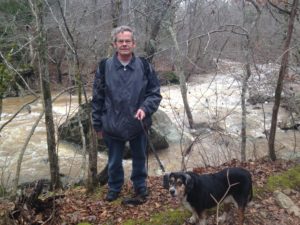
 Thursday was a lazy day around the RV, ending with a lovely dinner with David and Lucie. (Gotta get some recipes.) Even Rumple was happy playing with their puppy Buttercup.
Thursday was a lazy day around the RV, ending with a lovely dinner with David and Lucie. (Gotta get some recipes.) Even Rumple was happy playing with their puppy Buttercup. We got up early to take the Metro into Washington. It was at 7:15 a.m. at the last stop on the Orange Line that we realized the scope of the protest – the lines for tickets and for entry were enormous! There was a sea of happy people, with fuschia and pink hats bobbing in great numbers in the crowd. Fortunately, Paul and Lucie had the foresight to purchase our tickets the previous evening, and so our wait for the train was short. Anyone who planned to catch the train closer to Washington, including those poor souls trying to get to work, had a tough time getting onto crowded cars.
We got up early to take the Metro into Washington. It was at 7:15 a.m. at the last stop on the Orange Line that we realized the scope of the protest – the lines for tickets and for entry were enormous! There was a sea of happy people, with fuschia and pink hats bobbing in great numbers in the crowd. Fortunately, Paul and Lucie had the foresight to purchase our tickets the previous evening, and so our wait for the train was short. Anyone who planned to catch the train closer to Washington, including those poor souls trying to get to work, had a tough time getting onto crowded cars. We got off the train outside the main march area, as we were supposed to meet up with members of Yvonne’s union at Farragut Park to march together. The residential neighborhood we walked through was uncrowded, but many lawns and windows had signs welcoming the marchers – note the pink ribbons hanging from the trees in the background. I am guessing that the new administration is not too popular among the people who will have to work for it.
We got off the train outside the main march area, as we were supposed to meet up with members of Yvonne’s union at Farragut Park to march together. The residential neighborhood we walked through was uncrowded, but many lawns and windows had signs welcoming the marchers – note the pink ribbons hanging from the trees in the background. I am guessing that the new administration is not too popular among the people who will have to work for it. Farragut Park was full of marchers – a Japanese-American group with drummers, several unions, immigrant groups, etc., but only one other person from Yvonne’s teachers union. After a while, the groups coalesced into a march towards the main march. As an immigrant myself, I decided to march with an immigrant group (CAVA) right behind my friends. (My group of friends are in the picture above, with Lucie to the right and Yvone to the left.) Most of the people with me during this part of the march were speaking Spanish, but my main marching buddy was from Nigeria (which I consider my 3rd country, after Canada and the US).
Farragut Park was full of marchers – a Japanese-American group with drummers, several unions, immigrant groups, etc., but only one other person from Yvonne’s teachers union. After a while, the groups coalesced into a march towards the main march. As an immigrant myself, I decided to march with an immigrant group (CAVA) right behind my friends. (My group of friends are in the picture above, with Lucie to the right and Yvone to the left.) Most of the people with me during this part of the march were speaking Spanish, but my main marching buddy was from Nigeria (which I consider my 3rd country, after Canada and the US).


 It was heartening to see the number of people who brought kids – in some cases 3 or even 4 generations of women and some men marching together. (I got the permission of this young marcher’s mom to post his picture.)
It was heartening to see the number of people who brought kids – in some cases 3 or even 4 generations of women and some men marching together. (I got the permission of this young marcher’s mom to post his picture.) We were pushing towards the speakers’ stage which was between the National Museum of the American Indian (NMAI) and Independence Ave. However, the route was blocked. The police monitoring the march told everyone this but people continued to push forward – some because the stage was in sight, some because they were being pushed from behind and me because I was sure my group was ahead.
We were pushing towards the speakers’ stage which was between the National Museum of the American Indian (NMAI) and Independence Ave. However, the route was blocked. The police monitoring the march told everyone this but people continued to push forward – some because the stage was in sight, some because they were being pushed from behind and me because I was sure my group was ahead. Finally I got a text stating that Lucie et al were on the Mall near the National Gallery, so I started to make my way back towards them. By this time a couple of marchers had started to direct traffic, which helped a lot and it did not take too much to get to the Mall. However, there were still hundreds of thousands of marchers. After a while, the march started to proceed in 3 streams, along Jefferson, Madison and Constitution, so I waited downstream from the National Gallery, figuring I would see my friends when they passed. When this did not happen, I strolled back to the National Gallery, and finally caught up with them when a text got through.
Finally I got a text stating that Lucie et al were on the Mall near the National Gallery, so I started to make my way back towards them. By this time a couple of marchers had started to direct traffic, which helped a lot and it did not take too much to get to the Mall. However, there were still hundreds of thousands of marchers. After a while, the march started to proceed in 3 streams, along Jefferson, Madison and Constitution, so I waited downstream from the National Gallery, figuring I would see my friends when they passed. When this did not happen, I strolled back to the National Gallery, and finally caught up with them when a text got through. With that, we all marched towards the Washington Monument, from where the march was supposed to walk past the White House. Of course, the 3 streams merged there, and there was a huge amount of confusion, as the police were not prepared to handle a crowd this big, and with minimal cell signal there was no way to redirect the group. Amazingly, in this mess Lucie received a text from her son Isaac, and we were able to meet up with him, too.
With that, we all marched towards the Washington Monument, from where the march was supposed to walk past the White House. Of course, the 3 streams merged there, and there was a huge amount of confusion, as the police were not prepared to handle a crowd this big, and with minimal cell signal there was no way to redirect the group. Amazingly, in this mess Lucie received a text from her son Isaac, and we were able to meet up with him, too.
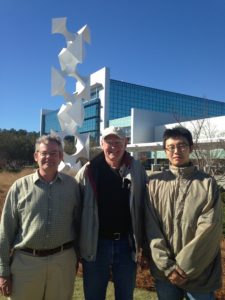
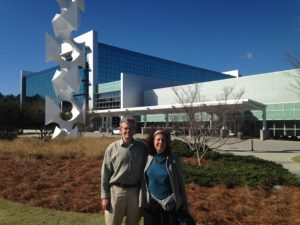
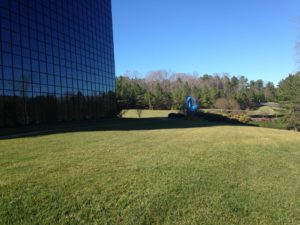 It was great to see Prof. Carl Meyer and his former graduate students Hansi and Ralph, whom we had talked with a lot during the sabbatical. (Carl and Hansi are above with Chuck – as I mentioned, we have been bad about taking photos with friends!) Hansi and Ralph both work at SAS, and Hansi was kind enough to take us for a walk on the large and park-like SAS campus. We had to stay away from the buildings though – the mirror-like glass gave a perfect reflection or Rumple, which sent him into a frenzy of protective barking. We were very impressed by the size and beauty of the campus, as well as all the artwork.
It was great to see Prof. Carl Meyer and his former graduate students Hansi and Ralph, whom we had talked with a lot during the sabbatical. (Carl and Hansi are above with Chuck – as I mentioned, we have been bad about taking photos with friends!) Hansi and Ralph both work at SAS, and Hansi was kind enough to take us for a walk on the large and park-like SAS campus. We had to stay away from the buildings though – the mirror-like glass gave a perfect reflection or Rumple, which sent him into a frenzy of protective barking. We were very impressed by the size and beauty of the campus, as well as all the artwork.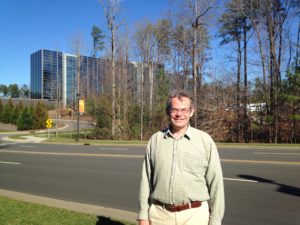
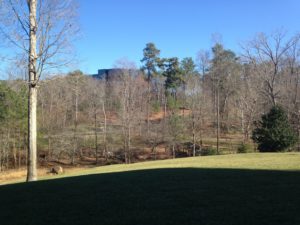 In an odd co-incidence another former PSU stat person, my friend Ruth Hummel, who works for a SAS division in Orlando FL was at a SAS business meeting. All of us went to the same cafeteria (in a building none of them worked in) and there I ran into Ruth. We managed to squeeze in a sunset walk on the campus with her.
In an odd co-incidence another former PSU stat person, my friend Ruth Hummel, who works for a SAS division in Orlando FL was at a SAS business meeting. All of us went to the same cafeteria (in a building none of them worked in) and there I ran into Ruth. We managed to squeeze in a sunset walk on the campus with her.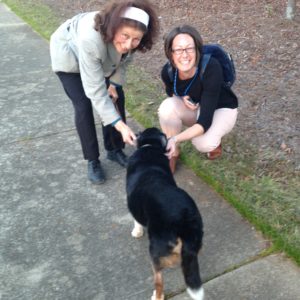 Between these two SAS walks, we scooted to the other side of Raleigh, to meet with another member of the working group, Shaina Race, who had a new baby just last week (and another 18 months ago). Did I mention that we have been doing a poor job of taking photos of our friends?
Between these two SAS walks, we scooted to the other side of Raleigh, to meet with another member of the working group, Shaina Race, who had a new baby just last week (and another 18 months ago). Did I mention that we have been doing a poor job of taking photos of our friends?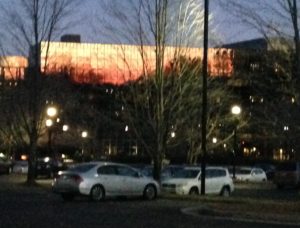
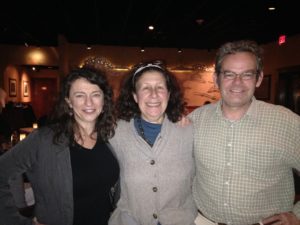
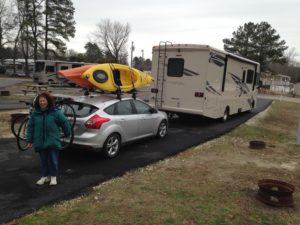 We headed out to the Research Triangle NC, where we plan to visit friends. So far, from waking up to getting on the road is taking us 3 hours. This includes walking the dog, emptying the fresh water and sewage tanks and packing up (as described earlier). Here we are fully loaded and ready to hop into the cab.
We headed out to the Research Triangle NC, where we plan to visit friends. So far, from waking up to getting on the road is taking us 3 hours. This includes walking the dog, emptying the fresh water and sewage tanks and packing up (as described earlier). Here we are fully loaded and ready to hop into the cab.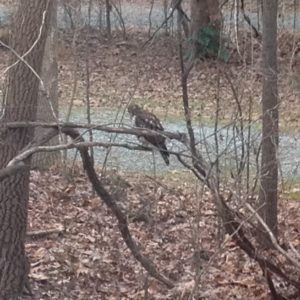 Having enjoyed our morning kayaking at Picture Lake, we had hoped to camp at one of the state parks on Jordan Lake, just a few miles from the Triangle. Unfortunately, in the winter the park gates are locked from 8 p.m. to 8 a.m. with no access to the campsites. Since this would have put a damper on our visits, we instead headed for a private campground, Springhill Park. This has proven to be very nice with large camping spaces and wooded areas between the RVs. It is also only a few minutes from Carrboro, one of our favorite towns in the Triangle region. Naomi took this picture of a hawk from her desk in the RV.
Having enjoyed our morning kayaking at Picture Lake, we had hoped to camp at one of the state parks on Jordan Lake, just a few miles from the Triangle. Unfortunately, in the winter the park gates are locked from 8 p.m. to 8 a.m. with no access to the campsites. Since this would have put a damper on our visits, we instead headed for a private campground, Springhill Park. This has proven to be very nice with large camping spaces and wooded areas between the RVs. It is also only a few minutes from Carrboro, one of our favorite towns in the Triangle region. Naomi took this picture of a hawk from her desk in the RV.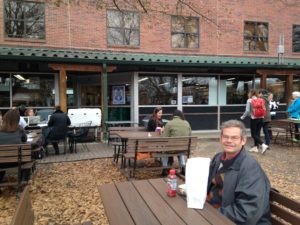 The next day we visited our old haunts in Carrboro, particularly the Weaver Street Market.
The next day we visited our old haunts in Carrboro, particularly the Weaver Street Market.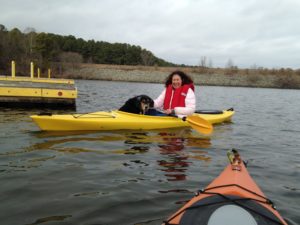
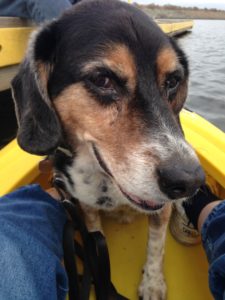 Having warm lovely weather, the next day we went kayaking on Jordan Lake. Rumple is an old dog who learned a new trick. Although he is afraid of the water, he was coaxed along and became Rumple the Kayak Dog. One advantage of the season is that hardly anyone else was on the lake except for a few
Having warm lovely weather, the next day we went kayaking on Jordan Lake. Rumple is an old dog who learned a new trick. Although he is afraid of the water, he was coaxed along and became Rumple the Kayak Dog. One advantage of the season is that hardly anyone else was on the lake except for a few 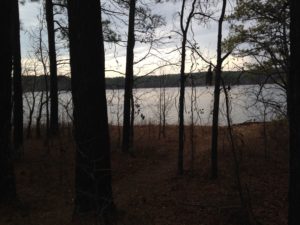 fishers who were very quiet. We saw a bald eagle and several great blue herons.
fishers who were very quiet. We saw a bald eagle and several great blue herons.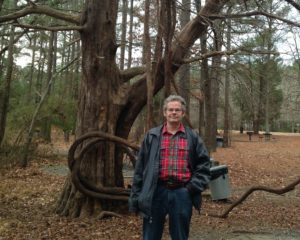 To reward Rumple for his good behavior, we also took a walk in the woods.
To reward Rumple for his good behavior, we also took a walk in the woods.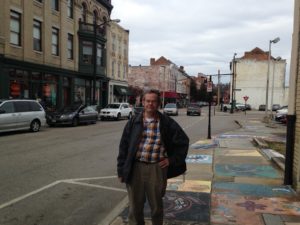 Downtown Petersburg is far from beautiful, but it is thriving with lots of restaurants and shopping. It has an excellent historic walking tour. The building below is the remnant of one of the oldest colonial era warehouses.
Downtown Petersburg is far from beautiful, but it is thriving with lots of restaurants and shopping. It has an excellent historic walking tour. The building below is the remnant of one of the oldest colonial era warehouses.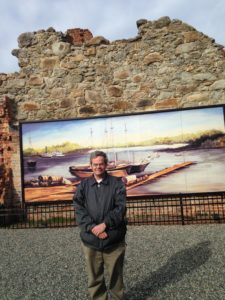
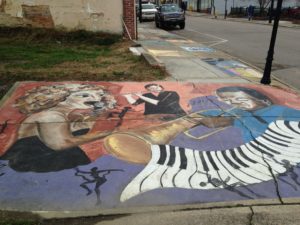 I guess because the buildings, although brick boxes, are historic, Petersburg has decided to have its murals on the sidewalks rather than on the side of buildings as has become popular elsewhere. You can see the effect in the photo of Chuck above.
I guess because the buildings, although brick boxes, are historic, Petersburg has decided to have its murals on the sidewalks rather than on the side of buildings as has become popular elsewhere. You can see the effect in the photo of Chuck above.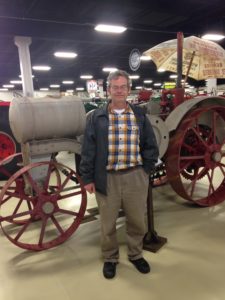
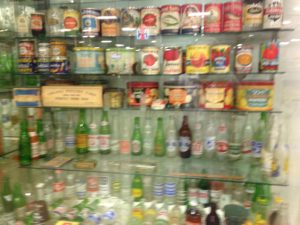
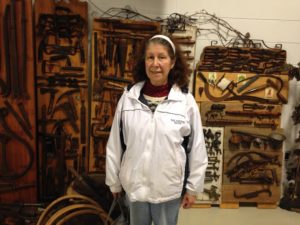 logging equipment, and the chainsaw tree.
logging equipment, and the chainsaw tree.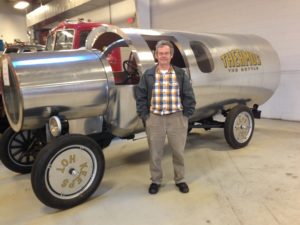
 And while I am sure we are all familiar with the Oscar-Meyer Weinermobile, who knewthat there was a Thermosmobile?
And while I am sure we are all familiar with the Oscar-Meyer Weinermobile, who knewthat there was a Thermosmobile?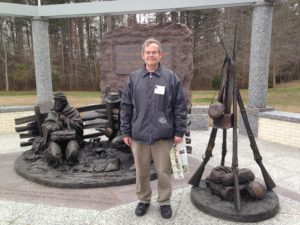 This private museum has a number of interesting exhibits about the daily life of soldiers during the war, as well as the remains of a plantation that was occupied by the Confederates during the months of the battle for Petersburgh. It has an excellent audio program which covers e.g. food, medical care, supplies, tents, etc, as well as letters from the soldiers. An expert told us about muskets during the war, and how the inexperience of the soldiers, the peculiarities of the weapon and the smoke from the gunpowder rendered the weapons effective (for the most part) at only a couple of hundred yards, rather than the 700 yards which can be attained by a sharp-shooter under ideal conditions.
This private museum has a number of interesting exhibits about the daily life of soldiers during the war, as well as the remains of a plantation that was occupied by the Confederates during the months of the battle for Petersburgh. It has an excellent audio program which covers e.g. food, medical care, supplies, tents, etc, as well as letters from the soldiers. An expert told us about muskets during the war, and how the inexperience of the soldiers, the peculiarities of the weapon and the smoke from the gunpowder rendered the weapons effective (for the most part) at only a couple of hundred yards, rather than the 700 yards which can be attained by a sharp-shooter under ideal conditions.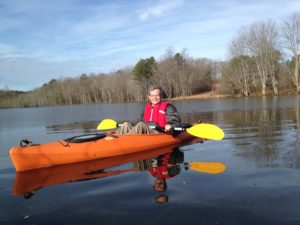 We started the day by kayaking on Picture Lake, which was frozen when we arrived but is now open. Actually, it turned out that only the sunny side of the lake was open, and we had some fun being ice breakers. We posted a very short video to YouTube because the sound of breaking the ice was really crunchy.
We started the day by kayaking on Picture Lake, which was frozen when we arrived but is now open. Actually, it turned out that only the sunny side of the lake was open, and we had some fun being ice breakers. We posted a very short video to YouTube because the sound of breaking the ice was really crunchy. 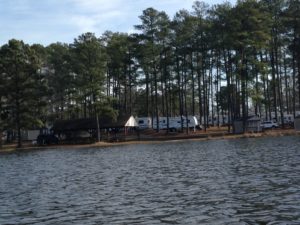 A view of the campground from the lake.
A view of the campground from the lake.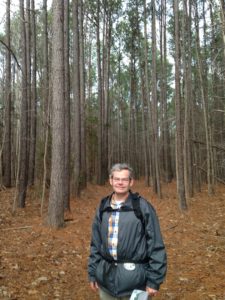 The quality of these interpretive films at the National Battlegrounds is excellent. However, for us the main attraction was the hike. We walked to the junction of the 5 roads (and our route home also took us through the junction) but mostly we walked in the woods with towering pines.
The quality of these interpretive films at the National Battlegrounds is excellent. However, for us the main attraction was the hike. We walked to the junction of the 5 roads (and our route home also took us through the junction) but mostly we walked in the woods with towering pines.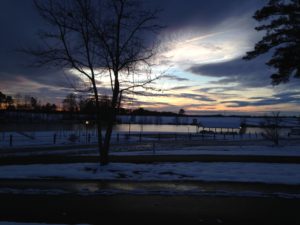 We are now camped at Picture Lake Campground, between Richmond and Petersburgh, an area rich in colonial and Civil War history. The area is fairly suburban but our campsite has a nice view to the west over little Picture Lake.
We are now camped at Picture Lake Campground, between Richmond and Petersburgh, an area rich in colonial and Civil War history. The area is fairly suburban but our campsite has a nice view to the west over little Picture Lake.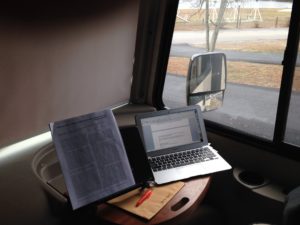 As you can see, I have a nice view towards lake as well as a view behind the RV via the rear view mirror. OK, you cannot really see this, but the lake is beyond the white swing set and is in my view when seated. (The white material in front of the desk is the windshield sun screen.)
As you can see, I have a nice view towards lake as well as a view behind the RV via the rear view mirror. OK, you cannot really see this, but the lake is beyond the white swing set and is in my view when seated. (The white material in front of the desk is the windshield sun screen.)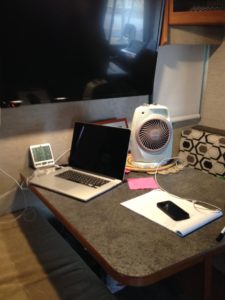 Chuck works at the dinette. This arrangement lets me have my back to the TV which is over the dinette, so I can work while Chuck is watching sports. The internet has been pretty good at all of our campsites so far, but if it is not we have our phone wifi hotspot as backup.
Chuck works at the dinette. This arrangement lets me have my back to the TV which is over the dinette, so I can work while Chuck is watching sports. The internet has been pretty good at all of our campsites so far, but if it is not we have our phone wifi hotspot as backup.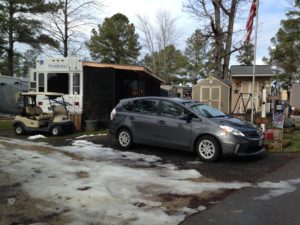

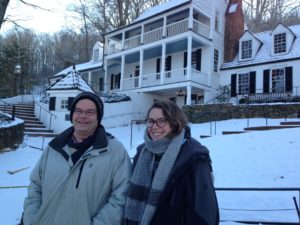
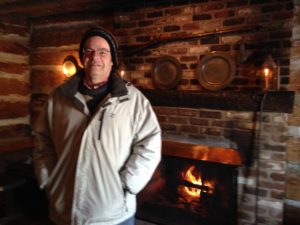 We had lunch at historic Michie Tavern, which is very atmospheric with hewn log walls and cozy fireplaces. However, the museum parts of the Tavern were also closed.
We had lunch at historic Michie Tavern, which is very atmospheric with hewn log walls and cozy fireplaces. However, the museum parts of the Tavern were also closed.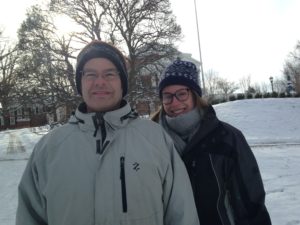
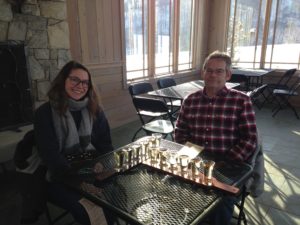
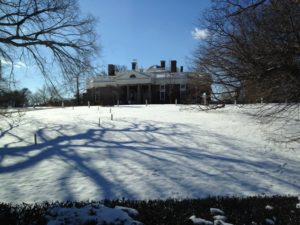
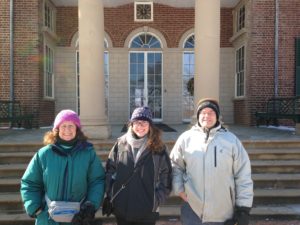
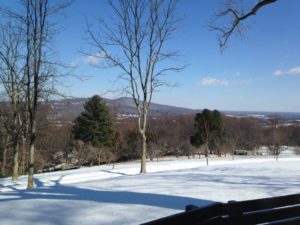 We went on a tour of Monticello. It was quite fascinating to learn about Thomas Jefferson and his many talents, which included engineering and horticulture, as well as political science. It would be interesting to understand why he did not free his slaves, not even his mistress and his children, when he had the opportunity. Ruined financially by the 1820 depression, I suppose he felt he could not release his human assets later in life.
We went on a tour of Monticello. It was quite fascinating to learn about Thomas Jefferson and his many talents, which included engineering and horticulture, as well as political science. It would be interesting to understand why he did not free his slaves, not even his mistress and his children, when he had the opportunity. Ruined financially by the 1820 depression, I suppose he felt he could not release his human assets later in life. After that it was time to head off to Richmond.
After that it was time to head off to Richmond.